#producer of polytunnels
Explore tagged Tumblr posts
Text
In Almería lies the world's largest concentration of commercial greenhouses, often referred to as ‘the sea of plastic’. This vast expanse of polytunnels, housing millions of kilos of fruits and vegetables mainly destined for export, stretches for hundreds of kilometers, a white panorama until the horizon. Also within this sea of plastic dwell the migrant workers who work to ensure Europe's supermarkets are stocked year-round. While they perform the vital task of ensuring Europe's all-season access to fresh produce, these workers often live in a state of physical and institutional vulnerability. This state of affairs remained largely hidden, until recent shocks like the Covid-19 pandemic and armed conflicts exposed the fragility of our food supply chains. Spain issues approximately 150,000 permits annually for seasonal laborers (European Parliament 2021). However, within just the province of Almería, there are more than 100,000 migrants working in greenhouses, 80% of them holding undocumented status in the country. This lack of legal recognition leaves the workers off official records, denying them universal rights such as labour rights and access to formal rental contracts. It is a dire situation that forces many to call the shanty towns surrounding the greenhouses their homes. During my research, I often heard how some workers pay up to 6,000 euros annually to greenhouse managers for the working contracts necessary to seek legal status in the country, turning the quest for legalization into a profitable business. Almería serves as a primary entry point for migrants traveling from West and North African countries to Europe. For those who cross the Mediterranean without visas - the majority of greenhouse laborers - this work is virtually the only option for income generation on arrival. While informal greenhouse jobs provide financial support to workers and their families back in their home countries, they also perpetuate vulnerability in livelihoods and employment, highlighting and embedding a stark contrast between EU citizens enjoying affordable food and the undocumented migrant workers compelled to work in precarious conditions to provide it.
144 notes
·
View notes
Text
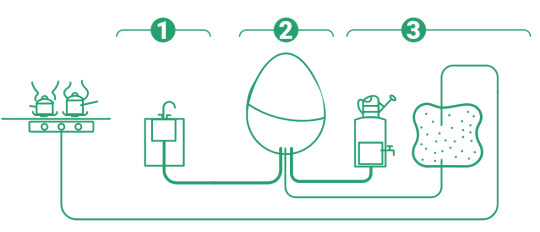
Kieran, a longtime mechanical engineer, had just invented Ireland’s first micro-scale anaerobic biodigester.
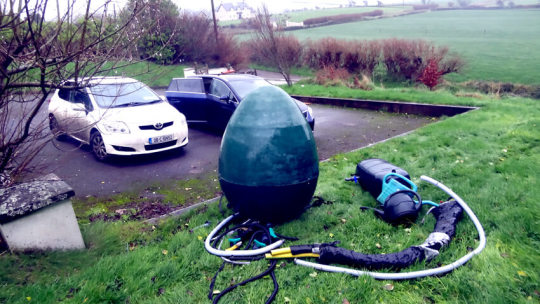
What does one even do with a micro-scale anaerobic biodigester?
Well, this particular anaerobic biodigester takes care of nearly 100% of your food waste.
You feed in all your scraps and waste – even hard-to-compost foods like cooked meats, dairy, cakes and liquids go in. Then the anaerobic bacteria get to work breaking down the waste.
After that, out come two very different ready-to-use products: a biogas for cooking and a nutrient-rich liquid fertiliser for gardening.
Food waste goes in. Gas and fertiliser come out.
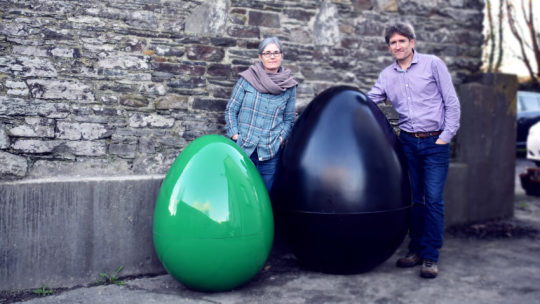
‘We were never really into gardening or growing food. That was the biggest thing to change with the digester,’ Kieran says.
‘During lockdown, we set up the polytunnel and started using the fertiliser from the egg to grow tomatoes and courgettes. Because not only have you got a way to get rid of your food waste, you’ve also got a way to grow more food. And the taste was extraordinary. We had loads of tomatoes so we gave them to friends. They couldn’t get over how tasty they were compared to what they were buying from shops.’
Fiona and Kieran have only seen positives come out of using the egg. They love cooking with the biogas they produce themselves, and having no bill for fertiliser.
#solarpunk#solar punk#reculture#solarpunk aesthetic#solarpunk AF#mygug#ireland#solarpunk innovation#biodigester#food waste into cooking gas and fertilizer#circular food
49 notes
·
View notes
Text
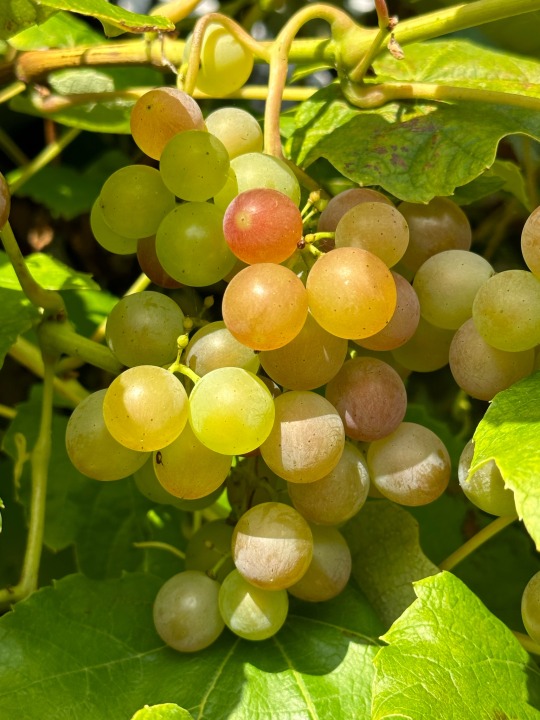
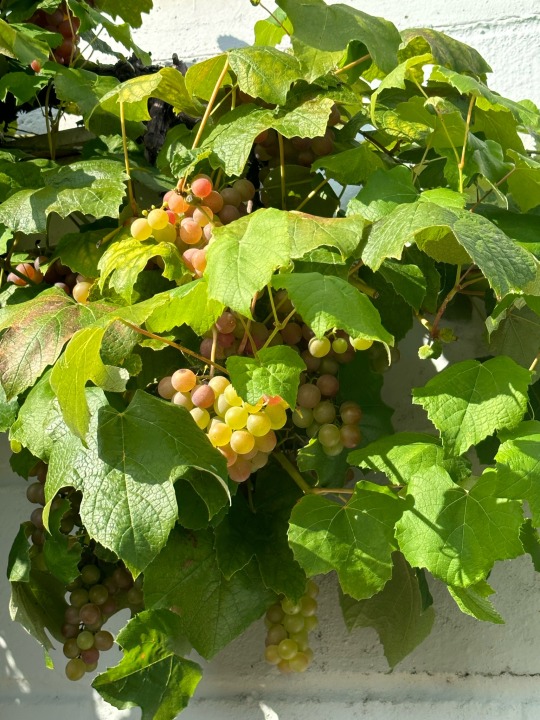
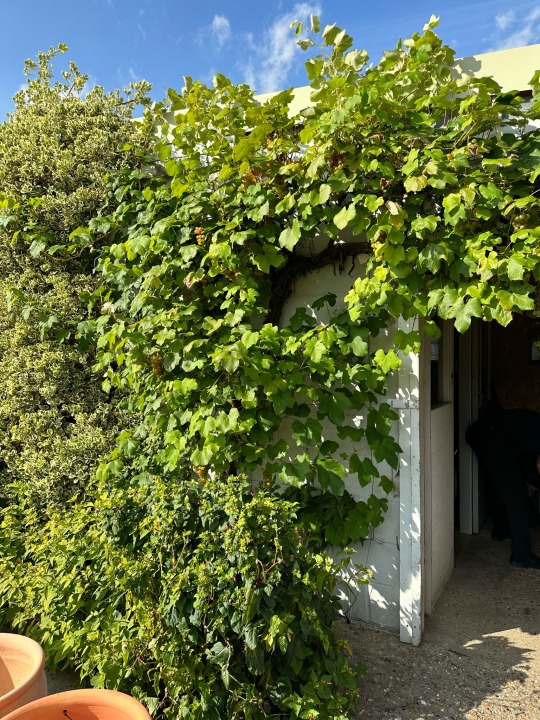
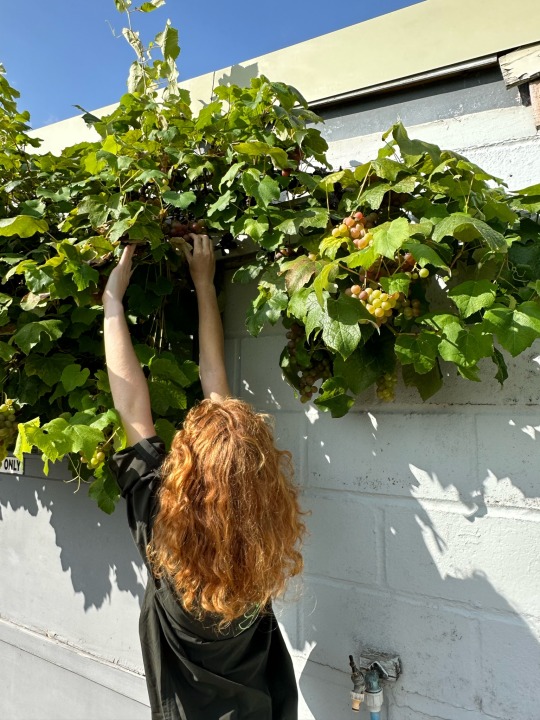
Plant of the Day
Sunday 1 October 2023
It was great to see and taste (with permission!) Vitis vinifera 'Fragola' (strawberry grape vine) at the Beth Chatto Garden, Essex. This is a productive variety that produces grapes that ripen in September with a lovely hint of strawberry flavour. The plant is good for cooler climates and it can be grown outdoors or under the protection of a greenhouse, polytunnel or conservatory. Fortunately there was a plant for sale in the nursery to take home to my Polycrub.
Jill Raggett
#vitis#vine#strawberry grape vine#grape#fruit#climber#plants#horticulture#gardens#garden#essex#Beth Chatto#productive garden
137 notes
·
View notes
Text
This is a worrying trend.
The UK's fruit and vegetable farmers have been struggling for several years due to our supermarkets choosing to stock cheaper foreign imports, rather than buying from local growers. Things have improved slightly this year. Five out of 6 of our major retailers have pledged to source fresh produce from UK farms... but. I do not think they have stopped buying the sub-standard fruit and vegetables from abroad.
Most of my arable farmland on the Dorset Downs is not suitable for growing vegetable crops... but after buying the neighbouring dairy farm in 2018, we gained a lot of extra previously unused land. some of which is in localised lowland areas with richer and deeper soil.
In 2021 we experimented with planting potatoes for the first time. Although the harvesting was rather labour intensive, it proved to be successful (and , more importantly profitable.)
In 2025 we intend to reintroduce potato, and other root crops on a slightly larger scale. We are also looking into the feasibility of growing fruit and salad in glasshouses, or polytunnels.
13 notes
·
View notes
Text
Stressed out trees helping charities restore valuable aspen forests | Trees and forests
In nature, deep in the Scottish Highlands, there is a polytunnel that dominates a small forest of slender gray aspen trees. It is known as the “tor-chamber”. Aspen is one of the UK’s rarest but most valuable trees. And to produce small and tender aspen seeds he collects from the charity Trees for Life, these 104 specimens were deliberately made to suffer. The water may be fast, the limbs may be…
0 notes
Text
Polytunnel Maintenance Is Essential

Regular maintenance of polytunnel covers and frame structures can significantly extend the lifespan and integrity, redress functionality and effectiveness to help prevent early polytunnel refurbishments. Whether, you're a large commercial grower, an independent producer or a home gardening enthusiast. Professional growers understand the importance of regular upkeep and how it relates to optimal effectiveness and cost savings, without needing to buy one or several new polytunnels, because of poor care and maintenance.
Repairing or Refurbishing Polytunnels
When most covers reach their five-year lifespan guarantee it might be time to consider replacing it. Whereas, polytunnel refurbishments to the frame offer a longer length of service, before needing structure parts to be repaired or replaced due to weather and wear and tear or accidental damage, renewing or refurbishing, doesn't necessarily mean dismantling the entire structure. It can involve replacing weathered polytunnel covers, adding or replacing sections, improving ventilation, installing new doors, or treating old ones, and even adding guttering systems for effective water collection. These timely upgrades can enhance the polytunnel's environment and integrity, making it optimally suitable for growing varieties of plants and protecting them from the UK weather elements and environments they are placed in.
When polytunnel covers require replacing or major and minor refurbishments are due, these observations help maintain the structural integrity of the polytunnel, adapting and extending it to new gardening goals or crop requirements. If you are planning to grow plants or crops that require specific conditions or deciding to change crop types to suit current trends, this can serve as a timely reminder to either purchase a new polytunnel or for complete polytunnel refurbishments.
Worth Checking the Cost of a New Polytunnel V Insurance
Taking out an insurance policy is an area overlooked by both gardeners and independent growers. While commercial operations might already have coverage under their business policies, individual gardeners and independent growers may want to consider looking at their home insurance can often extend to cover garden structures like polytunnels or take out an excess on shed and other housings within your home and garden. This may not cover areas such as normal wear and tear on polytunnel covers or for polytunnel refurbishments when their lifespan is met, they are for accidental and environmental damage.
Insurance companies require documented proof or site inspection of damage condition and repairs for the claims processing invaluable in the event of a claim, particularly when dealing with damage from weather incidents, accidental damage or failures, before considering your claim for a new polytunnel.
For farmers who integrate livestock into their gardening or farming activities, protecting your investment is important. Animals, even small ones like chickens and goats, without proper barrier controls in place, will cause damage to polytunnel covers and structures. Implementing accessory measures such as barrier and wire fencing, or containment and reinforced patches near ground level can help mitigate potential damage.
Conclusion
Maintenance involves regular checks, clean-ups, and occasional polytunnel refurbishments or replacement of polytunnel covers. Adapt to new gardening challenges or improve existing conditions. Insurance can prove beneficial for protecting this investment, particularly against unforeseen damage that can incur significant costs such as a new polytunnel.
Read More:
Commercial Polytunnels Offer Durability and Versatility Polytunnel Cultivation for Cuttings, Bulbs, Seedlings, and Young Plants
0 notes
Text

Mechanising the fields: The role of robotics in propelling development in agriculture
An extensive study of the sequence of incidents that happened in the recent past which had AI as the subject under scrutiny signalled one thing in unison, and that is that AI is essentially bad. Not because it was programmed to be a villain, but because humans manoeuvred it in such a way that it has involved itself more with mis-deeds than good. However, its character arc is not linear because the 2023 edition of the ‘AI for Good’ Global Summit that took place this July proved that AI is a domain with many faces, especially when it comes down to the use of AI in the field of agriculture.
This global summit provided a platform for over 30 cutting-edge robots to exhibit their range of skills which served as a testament for the potential of autonomous robots to spearhead progress towards the United Nations’ Sustainable Development Goal. Amidst the participants were robots that could be used in agriculture who displayed the importance of using high-technology in the field of agriculture. What it also showcased is how agriculture serves as a breeding ground for new technological developments and also as a key area of application of technologies that were developed somewhere else.
Robots and agriculture, a collaboration that we didn’t know we needed
The utilisation of AI in the agriculture market is expected to grow from US$ 1.7 billion in 2023 to US$4.7 billion by 2028. Despite this initiative being in its embryonic stage, these numbers do not come as a surprise especially because in a world where the demand for food is steadily increasing, agriculture is turning to innovative solutions, primarily robots, to optimise farming operations. The advanced machines that come into play are becoming the new workforce in agriculture and they have the ability to perform different tasks such as planting, irrigation, pest control, and soil analysis. Automating the field of agriculture can reap benefits such as higher productivity, lower labour expenses, and reduced reliance on harmful chemicals.
Farmers far and wide have already begun to embrace technology, including drones and remote-controlled grass and scrub cutting machines to improve productivity and minimise downtime and monitor their livestock with efficiency. For instance, in hilly regions, these robotic machines are particularly valuable as they can access and cultivate land that was previously unusable. Additionally, electric farm and factory robots with interchangeable tools are being developed, allowing for precise soil management minus the negative impacts of heavy tractors compacting wet soil. Soft robotic grasping technologies and sensors are helping out in the production of delicate crops giving farmers and consumers both something to look forward to. Moreover, soft robotics employs gentle methods like rubber cups or small bean bags to delicately grasp and harvest high-value produce like peaches and raspberries from plants without causing any form of damage. Thus, preserving the quality of such delicate crops.
Robots that are used in agri-tech are as cool as ones you see in ‘The Transformers’
Optimus Prime may be a master in hand-to-hand combat and a prodigy in parkour, but RoboBees (which can take-off vertically, hover and steer) could very well outdo it in terms of efficiency. Sarah Murray writing for The Financial Times about ‘Farm Robots Poised For Growth as Labour Costs Rise’ explains how RoboBees; developed by researchers at Harvard’s Wyss Institute, one of the most recent initiatives and is still in its nascent state, has the potential of eventually performing tasks such as crop pollination and environmental monitoring.
Currently, RoboBees are confined to laboratory settings, and their widespread commercial use in agriculture is still a distant prospect. These laboratory settings are spaces such as polytunnels and glasshouses where there is an absence of rain and mud. However, the ongoing progress in technology, coupled with challenges related to labour shortages, is making robots increasingly economically feasible for farm applications. This suggests that as technology continues to advance and labour availability remains a concern, the adoption of robots in agriculture may become a more realistic and practical solution in the near future. Furthermore, the fact that most of these robots are tailor-made and are often streamlined to function on a more plant-by-plant approach makes them even more attractive. For instance, ‘FarmWise’, a company based in California, has created a weeding robot that prioritises computer vision and artificial intelligence. This innovative robot can differentiate between weeds and crops, resulting in reduced labour expenses for farmers and allowing them to reduce their herbicide usage.
Another innovation that was exhibited at the ‘AI for Good’ Global Summit is ‘Digital Farm Hand’: a robotic platform specifically designed for smallholder farms, created by University of Sydney’s Australian Centre for Field Robotics (ACFR). This robot is programmed in a way that it could detect and identify objects within its environment, including plants and weeds. Owing to a capability of that scale, it can perform various tasks such as field mapping and gathering data on crop health and yield. But the feature which triumphs amidst all the ones it possesses is its capacity to transform the farming industry. By automating the process of recognising and removing weeds, this robot has the potential to decrease the dependence on harmful chemicals by farmers. This leads to cost savings and contributes to a safer and healthier environment for all parties who are shareholders in agriculture.
But do these robots live up to their brand image?
The potential that robots have cannot be denied. However it is worth highlighting that whether or not this potential will be discovered is up to the economic and political choices that the agricultural industry makes. For instance, a concern that is associated with the widespread adoption of agricultural robots is, when the costs of applying pesticides are diminished due to automation, it might lead to increased pesticide usage rather than a reduction, which could have adverse environmental and health implications. In addition, the use of more potent and hazardous pesticides might become more prevalent without human oversight. If heavier robots replace human workers, this could exacerbate existing issues related to soil compaction caused by the use of heavy machinery in farming, potentially harming the quality of the soil. The concerns don’t end there. The standardisation of food items to accommodate robotic automation may create a consumer expectation for perfectly uniform produce. This expectation could result in increased food wastage as fewer items meet these stringent criteria for sale, even if they are perfectly safe and nutritious to consume.
Apart from that, a major issue that has many small farm owners worried is that most efficient and high quality robots that are manufactured are available at extremely high costs. This will automatically gate keep them from gaining access to machinery that can actually make a change. This scenario can change if smaller, more advanced and affordable mobile robots become available for smaller farms. However, currently, most manufacturers of farm equipment are mainly focused on automating their large and more expensive products. This means that larger agricultural producers are the ones who will have a competitive advantage, as they can harness the cost savings and productivity benefits of robots. It is vital that the decisions that are made with regards to integrating robotics into agriculture are done wisely and done in a way that has everyone’s best interest at heart. The minute that it is politicised, it will stray away from the path that leads to achieving the goal of using robotics for SDGs. It will eventually become an antithesis to what experts recognise as measures used to ensure food security and combat climate change.
1 note
·
View note
Text
A Growing Industry of Protected Cultivation, Insights on Share and Growth
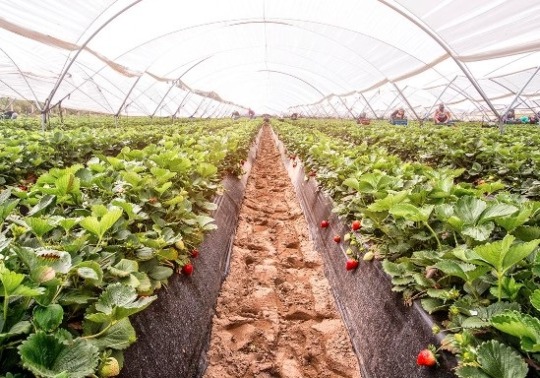
Introduction to Protected Cultivation
Protected cultivation, also known as greenhouse farming, revolutionizes traditional agricultural practices by providing controlled environments for optimal plant growth. This article delves into the burgeoning industry of protected cultivation, exploring market analysis, growth trends, and key players shaping its landscape.
Understanding the Protected Cultivation Industry
Overview of Protected Cultivation Industry
Protected cultivation refers to the practice of cultivating crops under controlled environmental conditions within structures like greenhouses or polytunnels. This method offers numerous advantages, including protection from adverse weather conditions, pests, and diseases, leading to higher yields and better quality produce.
Market Analysis of Protected Cultivation
The protected cultivation industry has witnessed significant growth in recent years, driven by increasing demand for fresh produce, rising concerns about food security, and advancements in greenhouse technologies. Market analysis reports indicate a steady expansion of the protected cultivation market globally, with a projected CAGR of 8% over the next five years.
Key Components of Protected Cultivation Market
Market Growth Trends
Protected cultivation market growth is fueled by factors such as urbanization, changing dietary preferences, and the need for sustainable agricultural practices. As consumers become more health-conscious and environmentally aware, there is a growing demand for locally grown, pesticide-free fruits and vegetables, driving the expansion of protected cultivation.
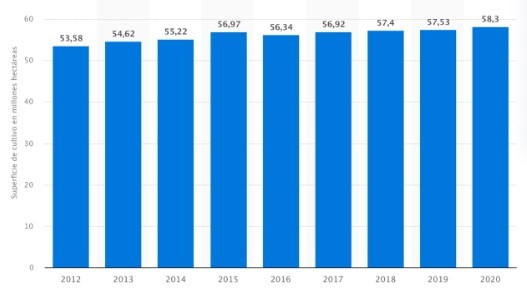
Click here – To know more about Crop Protection Market
Market Outlook and Revenue Forecast
The outlook for the protected cultivation market is optimistic, with experts forecasting continued growth in the coming years. Revenue projections indicate a steady increase, with The Global Market expected to surpass USD 50 billion by 2025, driven by investments in modern greenhouse technologies and supportive government policies promoting greenhouse farming.
Market Size and Share Dynamics
The protected cultivation market size varies across regions, with developed economies like North America and Europe leading the way. However, emerging markets in Asia-Pacific and Latin America are also experiencing rapid growth, fueled by increasing adoption of protected cultivation methods and rising demand for fresh produce.
Major Players in the Protected Cultivation Market
The protected cultivation market is characterized by the presence of several key players, including:
GreenTech Agro Corp
Polyhouse Solutions Ltd.
AgriPlast Industries
HortiMaX B.V.
Richel Group
These companies specialize in greenhouse technology, equipment manufacturing, and agricultural inputs, playing a crucial role in driving innovation and technological advancements in the industry.
Conclusion
Protected cultivation offers a sustainable solution to meet the growing demand for fresh, high-quality produce in an increasingly urbanized world. With advancements in greenhouse technologies and supportive government policies, the protected cultivation market is poised for continued growth and innovation, shaping the future of agriculture.
#Protected Cultivation Market Analysis#Protected Cultivation Market Demand#Protected Cultivation Market Forecast#Protected Cultivation Market Growth#Protected Cultivation Market Outlook#Protected Cultivation Market Revenue#Protected Cultivation Market Size#Protected Cultivation Market Trends#Protected Cultivation Market#Protected Cultivation Industry#Protected Cultivation Market Share#Protected Cultivation Industry Research Reports#Protected Cultivation Market Research Reports#Protected Cultivation Market Major Players
0 notes
Text
Extending Your Growing Season with Polytunnel Greenhouses

Polytunnel greenhouses, also known as hoop houses or high tunnels, offer numerous benefits that make year-round gardening easier and more successful. These structures are made of a metal frame covered with a durable polyethylene or polyvinyl plastic, creating a protected environment for plants. Here are the benefits of using polytunnel greenhouses for year-round gardening:
Extended growing season: Polytunnel greenhouses provide a controlled microclimate, which helps extend the growing season. The enclosed space traps heat from the sun, creating a warmer environment during colder months. This allows you to start planting earlier in the spring and continue growing crops well into the fall or even winter, depending on your climate.
Frost and cold protection: One of the primary advantages of polytunnel greenhouses is their ability to protect plants from frost and cold temperatures. The plastic cover acts as a barrier, shielding plants from chilly winds and maintaining a more stable temperature inside the greenhouse. This protection is especially crucial for sensitive plants and tender crops that may not survive outdoors during freezing temperatures.
Improved plant growth: The controlled environment inside a polytunnel greenhouse promotes optimal plant growth. The increased warmth and protection from harsh weather conditions allow plants to grow faster and healthier. Additionally, the higher humidity levels inside the greenhouse can benefit certain plant species that thrive in such conditions.
Reduced water usage: Polytunnel greenhouses minimize water evaporation, especially during hot and sunny days. The enclosed space helps retain moisture, reducing the frequency of watering and conserving water resources.
Protection from pests and diseases: The plastic cover of polytunnel greenhouses acts as a physical barrier, preventing many pests and diseases from entering the growing area. This reduces the need for chemical pesticides and fungicides, promoting a more natural and eco-friendly approach to gardening.
Versatility: Polytunnel greenhouses come in various sizes and designs, making them versatile for different gardening needs. They can be used to grow a wide range of crops, including vegetables, herbs, fruits, flowers, and even exotic or tropical plants that may not thrive in the local climate.
Easy assembly and portability: Polytunnel greenhouses are relatively easy to assemble and disassemble, making them portable and suitable for temporary gardening spaces. If you move or want to change your gardening location, you can dismantle the structure and set it up elsewhere.
Cost-effective: Compared to traditional glass or permanent greenhouse structures, polytunnel greenhouses are generally more affordable. They offer a cost-effective way to protect and nurture your plants throughout the year without the higher expense of building a permanent greenhouse.
Overall, polytunnel greenhouses provide an excellent solution for year-round gardening, enabling you to enjoy fresh produce and beautiful flowers regardless of the season. Whether you're a seasoned gardener or just starting, a polytunnel greenhouse can significantly enhance your gardening experience and productivity.
0 notes
Text
Organic Garden specializes in the production and assembly of high-quality polycarbonate polytunnels. Our greenhouses are produced with a 4mm thick polycarbonate which is covered by a 12-year guarantee by our supplier. The construction of our greenhouses is produced with highly durable galvanized steel with a closed profile within the base of the construction. This makes the construction far more durable and resistant to corrosion than standard greenhouses available on the market.
Polycarbonate Galway
Greenhouse Ireland
Polytunnel Galway
1 note
·
View note
Photo

It’s Presidents' Day this coming Monday, February 20th, so what better way to observe the occasion than by preparing some quintessentially American Presidential fare? The gustatorial tastes of each White House occupant have often served as a mirror of the times, with certain dishes, such as the squirrel stew and squirrel soup relished by Presidents William Henry Harrison and James Garfield respectively, having long since fallen out of favor (squirrels everywhere are breathing a sigh of relief). However, several past presidents’ culinary proclivities have stood the test of time and modernized versions of them appear on dinner tables and restaurant menus to this day. Here a few notable foods favored by presidents past and present that can be easily sourced at your Down to Earth farmers market over this long Presidents' Day weekend. Apple Cider John Adams, who served as the second president of the United States, proclaimed on numerous occasions that aged cider made from New England apples was one of only a handful of things in life he needed for continued health and happiness. In fact, he drank a “gill” (approximately four ounces) of hard cider every morning for breakfast throughout the course of his presidency and lived in good health till he passed away at 90 years old. While most apple cider you’ll find in the farmers market is unfermented and alcohol-free, it is sure to contain many of the same salubrious, happiness-promoting properties that Adams touted. This locally made apple cider is produced by pressing and collecting the unfiltered juice from apple pulp that is then strained to remove debris and pasteurized for safety. Pick up a jug of fresh apple cider from the farmers market this weekend to enjoy chilled as a standalone beverage or as part of these yummy cocktail recipes. And don’t forget to raise a toast to President John Adams while you’re at it…Cheers! Bacon Despite his considerable stature reaching 6’4” in height, Abraham Lincoln was reputed to have been a rather spartan eater who enjoyed simple, plainer foods. He did have his vices though as, according to the 16th president’s last bodyguard, Abe was “particularly fond of bacon” which in his day described any slice of pork that had been salted and cured. The bacon you’ll find being sold in your local farmers market comes from the side or belly of pastured hogs which have been humanely raised in a similar fashion to the way pigs were back in Lincoln’s time. Unlike industrially reared swine that are confined to small spaces and fed corn and soy, these free-roaming animals are raised without the use of hormones or steroids while enjoying ample exercise and a biologically appropriate diet of naturally foraged foods supplemented by vegetarian feed. Studies have shown that the nutritional value of meat from pastured pigs that consume grass and forage is greater than that from conventionally raised pigs including having higher amounts of protein and vitamin E. So, this Presidents' Day weekend, why not tip your hat to President Lincoln by sizzling up some crispy, tasty rashers of free-range farmers market bacon for breakfast? Broccoli President George H. W. Bush once famously proclaimed that he did not like broccoli, having been made to eat it as child, and would not consume any more of it now that he had reached the office of POTUS. In contrast to the broccoli-bashing Bush, and perhaps in a bit of a tongue-in-cheek gesture, President Obama told reporters that broccoli was his “favorite food” during an anti-obesity event at the White House in 2013. Love it or hate it, there’s no denying that broccoli is chockfull of important nutrients such as vitamins C and K, fiber, iron, and potassium. It also boasts higher amounts of protein than most other vegetables. The broccoli you’ll find in our farmers markets during the colder months has typically been cultivated in greenhouses and protective polytunnels, although it can also be grown in open fields. Like many other winter-grown crops, broccoli benefits from a phenomenon known as cold-sweetening which is when chilly temperatures cause sugars to accumulate in the plant and render it sweeter in taste than at other times of the year. Pick up a head of sweet winter broccoli at the farmers market this Presidents' Day weekend and try it raw, steamed, grilled or stir-fried. Goat Cheese Gateau with Tomato Jam While in office, President Trump made no secret of his love for fast food. However, for their first state dinner honoring French President Emmanuel Macron in 2018, the president and first lady chose to skip the burgers and diplomatically fuse American and French cuisine via an appetizer of goat cheese gateau with tomato jam, buttermilk biscuit crumbles, and young lettuces from the White House garden. This presidential farm-to-table creation can be replicated in the form of goat cheese and tomato jam crostini that also makes for a fantastic and easy-to-prep party appetizer. Source the bulk of the ingredients for this delicious crostini recipe at the farmers market and substitute whipped feta for goat cheese if that is easier to come by. Be sure to pick up some jars of Eltee’s Goods Tommy Jams next time you spy them in the market. Each jar is packed with one pound of New York State grown tomatoes and made with zero additives, preservatives or thickeners to give you that summer tomato fix all year long.
#downtoearthmkts#presidentsday2023#presidentialfood#presidentialfoods#eatlocal#shoplocal#buylocal#tomatojam#goatcheesegateau#bacon#applecider#broccoli
1 note
·
View note
Photo



While I was Huelva, Spain, with the SOC-SAT union, we went to visit strawberry workers at their chabolas. These are settlements made out of old polytunnels. These are settlements of workers who have no papers - those that have papers arrive via a process called contract-in-origin, where workers are hired in Morocco, stay for the duration of the harvest at their assigned farm, and then are deported. Those who want to stay longer, bring their family over, or do not want to work at their assigned farm often end up in a chabola.
I remember this woman and her family. She had come from Morocco originally. I didn’t understand the full extent of the conversation, it was in Arabic and translated via the Moroccan FNSA members who were with us, but she worked at a strawberry farm where the managers treated her very badly and didn’t pay her properly. What I did understand though was when she held up the water she had to drink to compare with the bottled water we brought with us. She had to drink collected rainwater, gathered using yet more leftover plastic from the farms. The water was a light green from the agrichemicals that stained the plastic.
The Andalucian government does not provide any sanitary or water services to the chabolas. There are no shops nearby. When the British magazine Ethical Consumer paid for solar panels for the chabolas via a fundraiser (fires caused by oil generators are a major hazard, hundreds get burned out of their homes every year), the Guardia Civil confiscated them and took the union organiser that installed them to court. We saw that 3 of the 6 panels were still standing at least.
350,000 tonnes of strawberries are produced in Huelva each year. If you see a strawberry in a supermarket that says it came from Spain, it will have come from Huelva. It is a billion euro industry require 100,000 workers to grow, harvest, and transport the red gold. And this is how those workers live.
255 notes
·
View notes
Text
When I picture my Someday Farm I picture
- a sunroom filled with shelves of microgreens to sell to local restaurants
- a dozen or so low polytunnel, no till, permanent raised garden beds companion growing produce and fresh herbs for the farmers market and maybe a local grocer
- a seasonal sunflower maze in the summer and a corn maze in autumn
- a pick your own pumpkin patch with dozens of beautiful heirloom varieties
- a small orchard of apple trees for hard cider production
- a roadside shop converted from my garage where I sell frozen pumpkin and apple pies, ciders, pumpkin apple and berry wines, apple and pumpkin butters, and decorative wreaths made from the glass corn of the corn maze
Cottagecore dreamers please reblog with your Someday plans
2 notes
·
View notes
Text
Find Out What You’re Local Polytunnel Supplier Can Offer You

Local polytunnel suppliers provide services from complete or part polytunnel refurbishments to commercial polytunnel repairs and cleaning services, addressing current issues such as tears in the cover, bent frames, or malfunctioning ventilation systems. These are generally quick fixes that prevent small issues from becoming major problems. Regular maintenance is crucial, especially for larger commercial structures, to ensure that polytunnels and their covering continue operating efficiently without unexpected downtime, which can significantly affect productivity.
Polytunnel Services
Polytunnel suppliers specialise in comprehensive services including installation, construction, repair, recovering, and refurbishment, they supply most things associated with polytunnels and accessories. They assure that completed polytunnel refurbishments and new polytunnels sold, meet the evolving needs of their users. From newly manufactured kits and custom bespoke designs tailored to specific needs in all shapes and sizes. Whether for small garden applications or large-scale commercial agriculture, the supplier works closely with clients from the planning stage, discussing dimensions, the best materials, and the intended use. Materials such as UV-stabilized polythene coverings to frame and hoops made from durable galvanised steel, or aluminium frames are selected based on their durability, efficiency, and customised suitability to local climatic conditions, ventilation options and wooden treated frames for entrances are available on bespoke choices.
Other Services
Polytunnel refurbishment and extensions on all types of installations can be achieved. Specialist refurbishment and recovering services are necessary for extending the integrity and functionality of these robust and resilient structures. This can involve a thorough overhaul of the structure and its components, such as replacing the cover, after 5 to 8 years with more durable materials, checking all fittings and bent or damaged frame parts, replacing or repairing frame fittings, enhancing ventilation systems, and integrating advanced temperature control and irrigation systems where required.
Polytunnel refurbishments are not always about fixing existing problems, they involve a more proactive in incorporating the latest technological advancements to improve the overall performance of the polytunnel, changing the design for client cultivation requirements and adding an extension or planning larger entrances and walkways.
Professional Polytunnel Suppliers
The guarantee of successful polytunnel refurbishments and installations heavily relies on the expertise of the installation team. Professional polytunnel suppliers look to employ skilled personnel, trained in the nuances of installation and construction. Readily equipped with the necessary tools and proficient in assembling structures but also knowledgeable about local building restrictions and environmental regulations, ensuring that each installation is compliant and secure.
Each new polytunnel or refurbishment is unique to its intended purpose, whether for growing certain crops, storing machinery, harvested produce, or housing chickens and livestock. Bespoke customisation involves the whole housing system and can be fitted with automated irrigation and heating tailored for optimal growing conditions or required storage environments.
The Importance of Polytunnel Refurbishments and Repairs
Choosing between polytunnel repairs and full refurbishments depends largely on the age, condition, and current functionality. Certain polytunnel repairs might suffice for newer structures with minor issues. Older and more extensively used commercial-sized ones often require comprehensive refurbishments, the stringent demands placed on the commercial horticulture and agriculture business and the environment they are located in. Polytunnel repairs and renewals, not only restore the structure to its original integrity they allow for adaptations to current practices and improved technologies. Significant returns on refurbishments and repairs provide enhanced durability and improved health and growth to crop yields.
Conclusion
Polytunnel suppliers are a vital link and integral to modern developments and practises in commercial horticulture, agriculture, and simple gardening techniques, in their approach to professionally executed services, from installation to polytunnel repairs and refurbishments. Their expertise in custom design, coupled with an in-depth understanding of agricultural requirements and local conditions, enables them to offer solutions that are not only practical but also innovative, ensuring that clients receive the best possible outcome.
Read More:
Polytunnel Installation and Construction in the UK Added Sturdiness and Robustness of Polytunnel Builds
0 notes
Text
Exploring the Protected Cultivation Industry: Insights and Analysis

Introduction
The Protected Cultivation Market stands as a beacon of innovation and sustainability in modern agriculture. With the increasing demand for fresh produce and the challenges posed by changing climates, protected cultivation techniques offer a solution to ensure year-round productivity and crop quality. This article provides a comprehensive analysis of the Protected Cultivation Market, shedding light on its demand dynamics, growth prospects, and key players.
Protected Cultivation Market Analysis: Understanding Market Dynamics
Protected Cultivation Market Analysis offers valuable insights into the various techniques, structures, and technologies utilized in controlled environment agriculture. It encompasses a wide range of practices, including greenhouse cultivation, polytunnel farming, and hydroponic systems. The global Protected Cultivation Market is estimated to grow at a CAGR of 8% from 2021 to 2026, driven by the increasing adoption of protected cultivation methods worldwide.
Market Demand: Meeting the Growing Need for Fresh Produce
The Market Demand for protected cultivation arises from the rising consumer preference for locally grown, pesticide-free produce. Consumers are increasingly seeking out fruits, vegetables, and flowers cultivated in controlled environments for their superior quality and extended shelf life. The demand for protected cultivation structures is expected to surge by 12% annually over the next five years, driven by the need for climate-resilient agriculture.
Market Research Reports: Guiding Informed Decision-Making
Market Research Reports play a crucial role in providing stakeholders with actionable insights into market trends, consumer behavior, and competitive landscape. These reports aid growers, suppliers, and investors in making informed decisions regarding investments, crop selection, and market expansion strategies. Companies leveraging market research insights witness a 15% increase in profitability compared to those operating without comprehensive market analysis.
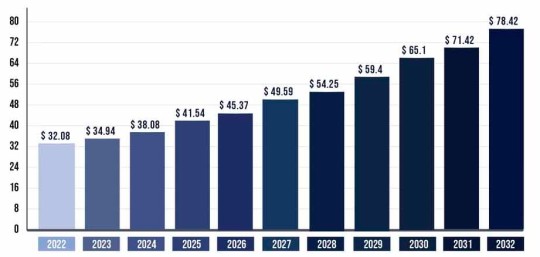
Click here – To Know more about Crop Protection Industry
Market Forecast: Anticipating Future Growth Trajectories
A forward-looking Market Forecast enables stakeholders to anticipate trends, opportunities, and challenges shaping the future of protected cultivation. It helps in identifying emerging technologies, market gaps, and potential areas for investment. The global market for protected cultivation equipment is projected to reach $15 billion by 2025, with greenhouse structures accounting for the majority of the market share.
Market Growth: Harnessing Innovation for Sustainable Agriculture
Market Growth in protected cultivation is fueled by technological advancements, sustainable practices, and increasing awareness of food security. Companies investing in research and development to improve crop yields, resource efficiency, and environmental sustainability are driving innovation in the sector. The adoption of precision farming techniques in protected cultivation is expected to increase by 20% over the next decade, leading to enhanced productivity and resource optimization.
Market Revenue: Capitalizing on Economic Opportunities
Market Revenue in protected cultivation encompasses sales of greenhouse structures, growing systems, seeds, and other inputs. With the rising demand for premium produce, growers can command higher prices, contributing to revenue growth. The global market for protected cultivation supplies is estimated to exceed $50 billion by 2025, driven by increased investments in modern agricultural infrastructure.
Market Size: Evaluating the Scope of Industry Expansion
The Market Size of protected cultivation encompasses both traditional and modern cultivation methods, including high-tech greenhouses and vertical farming systems. It reflects the scale of operations, geographic spread, and diversity of crops grown under protected conditions. The market size of protected cultivation is expected to double by 2030, with Asia-Pacific emerging as a key growth region due to rapid urbanization and increasing demand for fresh produce.
Market Trends: Adapting to Evolving Consumer Preferences
Market Trends in protected cultivation include the adoption of smart technologies, vertical integration of supply chains, and the development of climate-resilient crop varieties. These trends reflect the industry's response to consumer demand for sustainable, locally sourced, and nutritionally dense food products. The adoption of controlled environment agriculture techniques is projected to increase by 25% in North America and Europe by 2025, driven by favorable government policies and consumer awareness campaigns.
Market Share: Identifying Key Players in the Industry Landscape
Protected Cultivation Market Share analysis helps in identifying industry leaders, emerging players, and niche segments within the protected cultivation market. It provides valuable insights into competitive strategies, market positioning, and potential partnership opportunities. The top five players in the global protected cultivation market account for over 40% of the total market share, highlighting the dominance of established players in the industry.
Conclusion
The Protected Cultivation Market presents immense opportunities for sustainable agriculture, food security, and economic growth. By harnessing innovation, technology, and market insights, stakeholders can navigate the evolving landscape of controlled environment agriculture and contribute to building a more resilient and prosperous future for farming communities worldwide. With the support of comprehensive market analysis and strategic planning, the industry is poised to thrive in the years to come.
#Protected Cultivation Market Analysis#Protected Cultivation Market Demand#Protected Cultivation Market Forecast#Protected Cultivation Market Growth#Protected Cultivation Market Outlook#Protected Cultivation Market Revenue#Protected Cultivation Market Size#Protected Cultivation Market Trends#Protected Cultivation Market#Protected Cultivation Industry#Protected Cultivation Market Share#Protected Cultivation Industry Research Reports#Protected Cultivation Market Research Reports#Protected Cultivation Market Major Players
0 notes
Text
This Is The Longest Cucumber In The World! – Guinness World Records (Pictures)
This Is The Longest Cucumber In The World! – Guinness World Records (Pictures)
Amateur gardener Sebastian Suski is the proud new owner of the world’s longest cucumber – a specimen of Cucumis sativus that until this week was growing in a polytunnel at his allotment. Despite the blisteringly hot summer in the UK, Sebastian – who was born in Poland but now lives in Southampton – was able to tend to his impressive patch of cucumbers and produce a whopper measuring 113.4 cm (3…
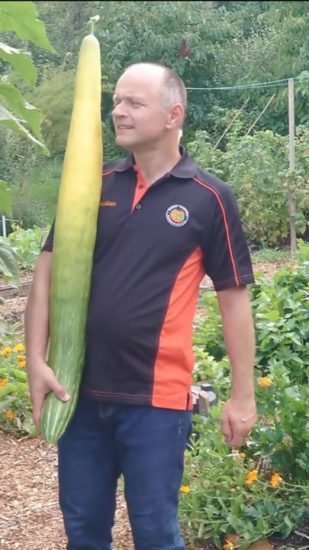
View On WordPress
0 notes